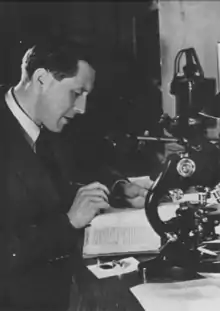Elke Mackenzie
Elke Mackenzie (11 September 1911 – 18 January 1990), born Ivan Mackenzie Lamb, was a British polar explorer and botanist who specialised in the field of lichenology. The standard author abbreviation I.M.Lamb is used to indicate this person as the author when citing a botanical name.[1]
Elke Mackenzie | |
|---|---|
 Elke Mackenzie, 1947 | |
| Born | 11 September 1911 Clapham, London, UK |
| Died | 18 January 1990 (aged 78) |
| Nationality | British |
| Alma mater | Edinburgh University |
| Scientific career | |
| Fields | Lichenology |
| Institutions | British Museum (Natural History) National University of Tucumán National Museum of Canada Farlow Herbarium of Cryptogamic Botany |
| Doctoral students | Vernon Ahmadjian Royall T. Moore |
| Author abbrev. (botany) | I.M.Lamb |
Early life
Lamb was born in Clapham, London, on 11 September 1911. Lamb's family moved to Scotland while she was a child, and she was enrolled in the Edinburgh Academy. After her graduation in 1929, she attended Edinburgh University. She earned her B.Sc. with Honors in Botany in 1933. She received a scholarship from the German Academic Exchange Service, and continued doing research in botany at the University of Munich and the University of Würzburg.[2]
Career
Lamb was appointed as an assistant keeper at the British Museum (Natural History) in 1935 under the direction of lichenologist Annie Lorrain Smith. Lamb became especially interested in the lichen flora of the antarctic, as it was comparatively unknown, and she began studying early British, French, and Belgian antarctic collections in Turkey and Paris. Lamb earned her Doctor of Science from Edinburgh University in 1942.[2][3]
Lamb is famous for her part in Operation Tabarin, a secret mission instigated by Churchill during the Second World War.[4] On the surface, it was an antarctic expedition organized to demonstrate British sovereignty in the Antarctic Peninsula. Lamb joined the crew in 1943. She collected lichen samples and conducted experiments on the accumulation of snow and subsequent thawing. Lamb discovered a number of lichen species, including Verrucaria serpuloides, the only known true marine lichen, thus making a considerable contribution to the taxonomy of Antarctic lichens.[5] Lamb remained in Antarctica until 1946.[2]
After the war, Lamb became Professor of Cryptogramic Botany at National University of Tucumán and traveled extensively in Argentina and Brazil.[4] In 1950, Lamb was put into contact with Erling Porsild, who hired her as a cryptogamic botanist at the National Museum of Canada in Ottawa. After the move to Canada, Lamb sold her private herbarium of 3,200 specimens to the Canadian Museum of Nature. She continued to collect, gathering specimens from all throughout Canada.[2]
In 1953, Lamb was offered the directorship of the Farlow Herbarium of Cryptogamic Botany by Harvard University, and she left Canada. Lamb returned to Antarctica in October 1964, where she began SCUBA investigations with her colleagues from France and Argentina, under a grant from the National Science Foundation and with the logistic support of the Argentine Navy. Lamb referred to this study as "Operation Gooseflesh."[2] For the three following years, Lamb continued to collect throughout Europe and Mexico.[2]
In 1971, Lamb was diagnosed with gender dysphoria, underwent a sex reassignment surgery, and renamed herself Elke Mackenzie. Mackenzie retired from the Farlow Herbarium in 1973. During the next six years, Mackenzie lost interest in her botany work, preferring to translate German botanical text books into English. She constructed an A-frame bungalow in Costa Rica, and moved there in 1976.[2]
In 1980, Mackenzie returned to Cambridge to live with her daughter, citing political unrest. She took up woodworking, but was diagnosed with Lou Gehrig's disease in 1983. She died in 1990.[2]
Legacy
Mackenzie is the namesake of one genus, Lambia, and several species. The list of species includes:
- Buellia lambii
- Neuropogon lambii
- Parmelia lambii
- Placopsis lambii
- Verrucaria mackenzie-lambii
Cape Lamb on Vega Island is named for Mackenzie.[6]
Awards
Lamb was the recipient of both the British and United States Polar Medals for her involvement in Operation Tabarin.[2]
Selected publications
Lamb published 43 papers over a 43-year period.[2]
- Lamb, I. M. (1936). Lichenological notes from the British Museum herbarium. I. Journal of Botany 74: 174-178
- Lamb, I. M. (1948). New, rare or interesting lichens from the southern hemisphere. I. Lilloa 14: 203-251
- Lamb, I. M. (1953). New, rare or interesting lichens from the southern hemisphere. II. Lilloa 26: 401-438
- Lamb, I. M. (1955). New lichens from northern Patagonia, with notes on some related species. Farlowia 4: 423-471
- Lamb, I. M. (1970). Antarctic terrestrial plants and their ecology, pp. 733-751. In M. W. Holdgate (ed.), Antarctic Ecology. London and New York.
- Lamb, I. M. (2018). The Secret South: A Tale of Operation Tabarin, 1943–46 (S. Haddelsey, R. Lewis-Smith, Ed.). Greenhill Books.
References
- IPNI. I.M.Lamb.
- Llano, G. (1991). I. Mackenzie Lamb, D.Sc. (Elke Mackenzie) (1911-1990). The Bryologist, 94(3), 315-320. Retrieved from http://www.jstor.org/stable/3243974
- Lamb, I. M. (1942). Monograph of the lichen genus Placopsis (Nyl). hdl:1842/32456.
- "Lamb, Ivan Mackenzie (1911-1990)". Cite journal requires
|journal=(help) - Haddelsey, S. (2014). Operation Tabarin: Britain's Secret Wartime Expedition to Antarctica, 1944–46. Stroud: History Press. ISBN 9780752493565.
- "Cape Lamb". Geographic Names Information System. United States Geological Survey. Retrieved 2013-05-24.
External links
- Biography of Ivan Mackenzie Lamb
- Obituary in The Lichenologist 23: 85-87. 1991
- Ivan Mackenzie Lamb's Studies of Marine Algae
- Llano, George A. 1991. I. Mackenzie Lamb, D.Sc. (Elke Mackenzie) (1911–1990). The Bryologist 94(3): 315–320. JSTOR
- Index Nominum Lichenum Inter Annos 1932 et 1960 Divulgatorum i–xii, 1–810, 1963 (I.M. Lamb's 810 page list of lichen names)
